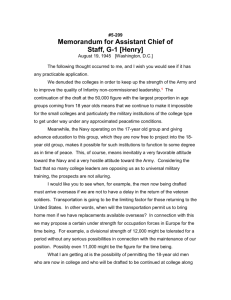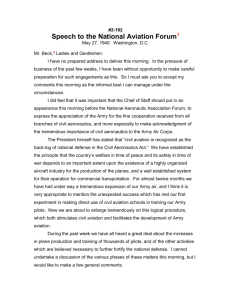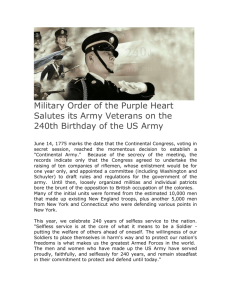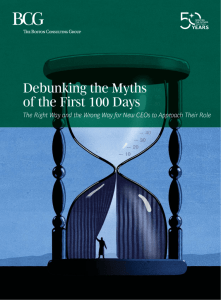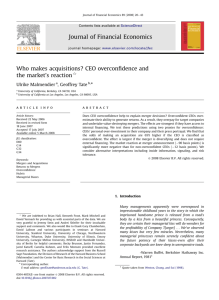How to Think Like Bill Gates, Annual Army Leadership Review and
advertisement
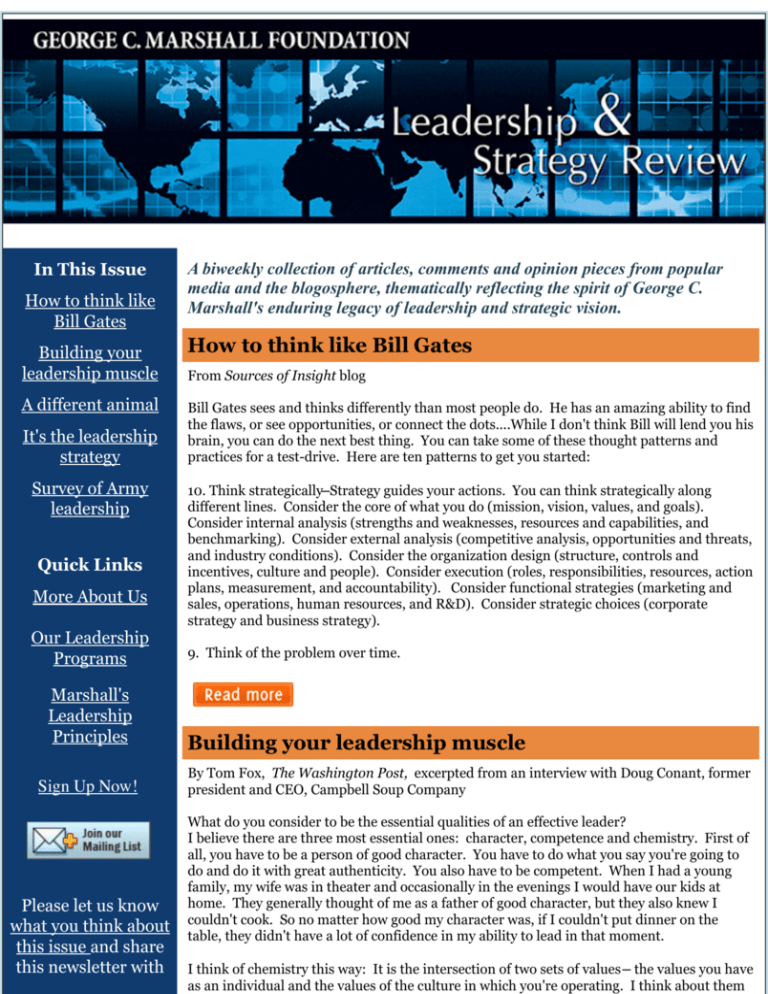
In This Issue How to think like Bill Gates Building your leadership muscle A different animal It's the leadership strategy Survey of Army leadership Quick Links More About Us Our Leadership Programs Marshall's Leadership Principles Sign Up Now! Please let us know what you think about this issue and share this newsletter with A biweekly collection of articles, comments and opinion pieces from popular media and the blogosphere, thematically reflecting the spirit of George C. Marshall's enduring legacy of leadership and strategic vision. How to think like Bill Gates From Sources of Insight blog Bill Gates sees and thinks differently than most people do. He has an amazing ability to find the flaws, or see opportunities, or connect the dots....While I don't think Bill will lend you his brain, you can do the next best thing. You can take some of these thought patterns and practices for a test-drive. Here are ten patterns to get you started: 10. Think strategically ̶Strategy guides your actions. You can think strategically along different lines. Consider the core of what you do (mission, vision, values, and goals). Consider internal analysis (strengths and weaknesses, resources and capabilities, and benchmarking). Consider external analysis (competitive analysis, opportunities and threats, and industry conditions). Consider the organization design (structure, controls and incentives, culture and people). Consider execution (roles, responsibilities, resources, action plans, measurement, and accountability). Consider functional strategies (marketing and sales, operations, human resources, and R&D). Consider strategic choices (corporate strategy and business strategy). 9. Think of the problem over time. Building your leadership muscle By Tom Fox, The Washington Post, excerpted from an interview with Doug Conant, former president and CEO, Campbell Soup Company What do you consider to be the essential qualities of an effective leader? I believe there are three most essential ones: character, competence and chemistry. First of all, you have to be a person of good character. You have to do what you say you're going to do and do it with great authenticity. You also have to be competent. When I had a young family, my wife was in theater and occasionally in the evenings I would have our kids at home. They generally thought of me as a father of good character, but they also knew I couldn't cook. So no matter how good my character was, if I couldn't put dinner on the table, they didn't have a lot of confidence in my ability to lead in that moment. I think of chemistry this way: It is the intersection of two sets of values ̶ the values you have as an individual and the values of the culture in which you're operating. I think about them your friends and associates Read previous issues Thanks to our Corporate Partners for Leadership Five-Star Member General Dynamics L-3 Communications Four-Star Member HDT Global Two-Star Member Booz Allen Hamilton DRS Technologies FedEx Fluor Rainier Investment Management One-Star Member AM General Association of the United States Army (AUSA) ATK Eni Petroleum GE Aviation SAIC SRA International Tawani Foundation in terms of what we used to do with Venn diagrams in grade school. You have two circles. One circle is your values and the other is the values of the enterprise. If those values are overlapping and there's harmony across some of the core values, you can then have good chemistry with that organization and you can thrive. If not, my experience is that you won't. A different animal seeks the no. 1 post; often it's not no. 2 By Phred Dvorak for The Wall Street Journal Carl Bass says an odd thing happened to him when he became chief executive of software maker Autodesk [a few years ago]. "My IQ jumped 10 points and I became much funnier, jokes the 50-year-old Mr. Bass, who had been Autodesk's chief operating officer for the previous two years. "When you're CEO, what you're saying is so amplified you have to be very careful," says Mr. Bass. His experience shows why the gap between No. 1 and No. 2 in a company is often bigger than many realize. CEOs not only perform different tasks from their second-in-commands ̶who typically focus on running operations ̶but they have to act differently, too. That means the two roles often demand very different personality traits, say people who have been there. CEOs talk about getting acclimated to the limelight. Longtime chief operating officers say they are used to working behind the scenes and submerging their egos. Their jobs focus them inward on the company's problems, while CEOs spend much of their time convincing outsiders of the company's strengths. It's the leadership strategy that matters By Josh Bersin, Contributor to Forbes Let's face it. CEOs come and go. But leadership, if developed in a comprehensive way, endures. In the last few years we've seen new CEO's at Yahoo, HP, Apple and other prominent companies, and in each case we watch to see if the CEO can "pull it off." Well, while the CEO is a very important person, our research shows that enduring business performance is really driven at much deeper levels: a focus on leadership strategy. Longterm business performance comes from leadership culture and careful and continuous development of leadership at all levels. It's not all about the CEO. In this research we looked at hundreds of companies over the last few years and correlated their business performance to a variety of different people and talent practices. Let me share some of these findings and best practices: 1. Link leadership strategy to business strategy. 2. Develop leaders at all levels. 3. Invest in leadership development. 4. Develop your leadership philosophy. Annual survey of Army leadership The Annual Survey of Army Leadership tracks trends in Army leader attitudes about leader development, quality of leadership, and the contribution of leadership to mission success. Each year, survey development begins with the identification of issues important to leadership and leader development. Main findings from the 2011 survey include: Getting Results, Preparing Oneself, and Leading Others are the most favorably rated core leader competencies. Army leaders are rated favorable on all leader attributes, especially Army Values and Technical Knowledge. Develop Others continues to be the lowest rated core leader competency across all levels, with only 45% rated effective at creating or identifying opportunities for leader development. Institutional courses/schools are not seen as effective in preparing leaders to develop their subordinates. http://usacac.army.mil/cac2/repository/casal_techreport2012-1_mainfindings.pdf The private, non-profit, independent George C. Marshall Foundation, located in Lexington, Virginia, prepares emerging leaders in military service, foreign service, public administration and business in the essentials of vision, strategy and leadership. Forward this email This email was sent to edrake@marshallfoundation.org by edrake@marshallfoundation.org | Update Profile/Email Address | Instant removal with SafeUnsubscribe™ | Privacy Policy. George C. Marshall Foundation | PO Box 1600 | Lexington | VA | 24450
